
可參考MPEP的2132 35 U.S.C. 102(a):
A person shall be entitled to a patent unless -
(a) the invention was known or used by others in this country,
or patented or described in a printed publication in this or a foreign country, before the invention thereof by the applicant for a patent.
因為102(a)指得是發明日,所以參考文獻若屬於發明人自己的作品,當然不會被用來當作核駁的引證案。
Applicant's disclosure of his or her own work within the year before the application filing date cannot be used against him or her under 35 U.S.C. 102(a). In re Katz, 687 F.2d 450, 215 USPQ 14 (CCPA 1982)
其中要注意的是102(a)中“others”的定義,只要是發明實體(inventive entity)中,有一人不相同則不論增或減,都陂定義為"by others":
The term "others" in 35 U.S.C. 102(a) refers to any entity which is different from the inventive entity. The entity need only differ by one person to be "by others." This holds true for all types of references eligible as prior art under 35 U.S.C. 102(a) including publications as well as public knowledge and use.
故只要inventive entity不同了,即使“swearing back”無法克服inventive entity不同的問題,一樣會落入102(a)的範圍。參考:
A prima facie case is made out under 35 U.S.C. 102(a) if, within 1 year of the filing date, the invention, or an obvious variant thereof, is described in a "printed publication" whose authorship differs in any way from the inventive entity unless it is stated within the publication itself that the publication is describing the applicant's work. In re Katz, 687 F.2d 450, 215 USPQ 14 (CCPA 1982).
雖然inventive entity已經不同了,還是有幾個方法可以補教。
第一個方法叫做“減法”:
Therefore, where the applicant is one of the co-authors of a publication cited against his or her application, the publication may be removed as a reference by the filing of affidavits made out by the other authors establishing that the relevant portions of the publication originated with, or were obtained from, applicant. Such affidavits are called disclaiming affidavits. Ex parte Hirschler, 110 USPQ 384 (Bd. App. 1952).
第二個方法叫做“加法”:
It is also possible to overcome the rejection by adding the coauthors as inventors to the application if the requirements of 35 U.S.C. 116, third paragraph are met. In re Searles, 422 F.2d 431, 164 USPQ 623 (CCPA 1970).
經過加減法使inventive entity相同之後,再“swearing back”,才可以不會再落入102(a)的範圍,但是還是要注意“statutory bar”,小弟將它翻做“法定不予專利事由”。
When the reference is not a statutory bar under 35 U.S.C. 102(b), (c), or (d), applicant can overcome the rejection by swearing back of the reference through the submission of an affidavit under 37 CFR 1.131. In re Foster, 343 F.2d 980, 145 USPQ 166 (CCPA 1965). If the reference is disclosing applicant's own work as derived from him or her, applicant may submit either a 37 CFR 1.131 affidavit to antedate the reference or a 37 CFR 1.132 affidavit to show derivation of the reference subject matter from applicant and invention by applicant. In re Facius, 408 F.2d 1396, 161 USPQ 294 (CCPA 1969).
關於37 CFR 1.131及37 CFR 1.132 affidavit等的部分,以後再做介紹。102(a)的部分還有一個要注意的地方,如果reference是屬於美國專利的話,則應該要考慮102(e):
Note that when the reference is a U.S. patent published within the year prior to the application filing date, a 35 U.S.C. 102(e) rejection should be made. See MPEP § 2136 - § 2136.05 for case law dealing with 102(e).
上面所說的小弟也覺得很奇怪,為何reference是屬於美國專利的話,則一定要以102(e)來核駁,不過我想美專 102是採用負面表列的方式,所以 審查委員可以使用任何一項,若一個reference落入102(a)和102(e)的範圍內,審查委員可以查用任何一條。同樣道理若reference 已經符合102(b)時,就不需要用102(e)來核駁。
沒有留言:
張貼留言